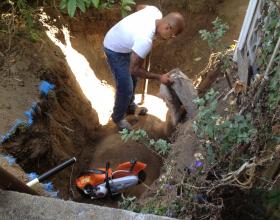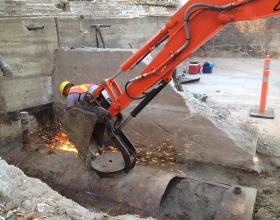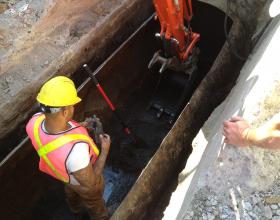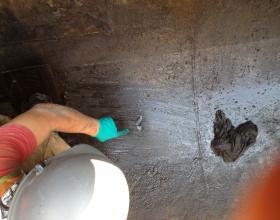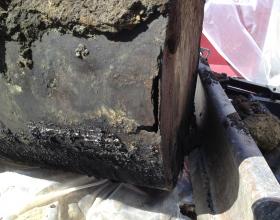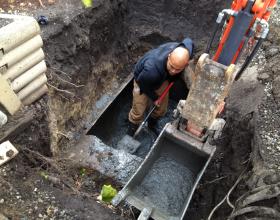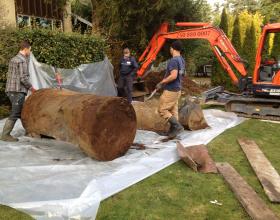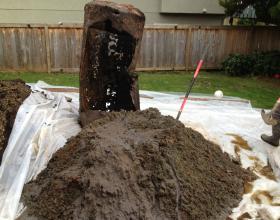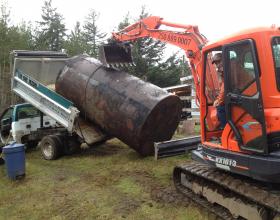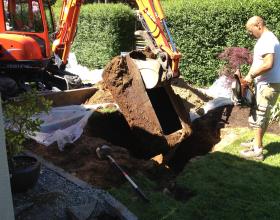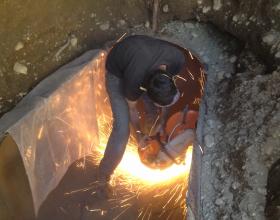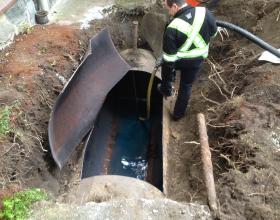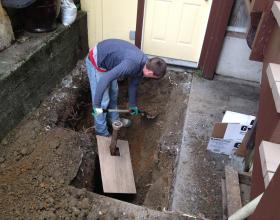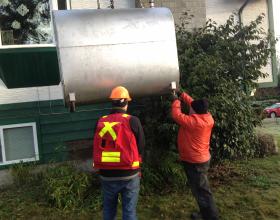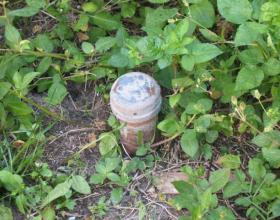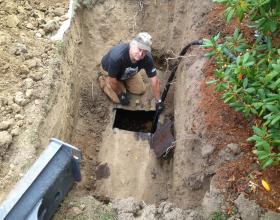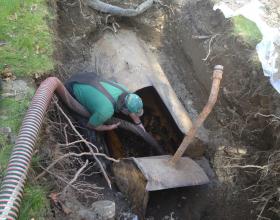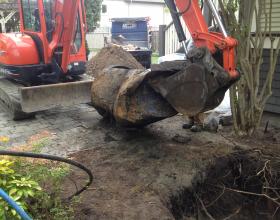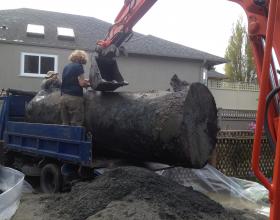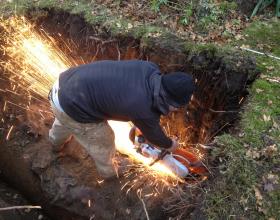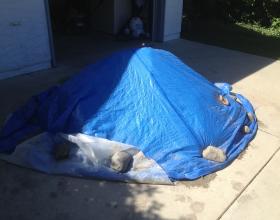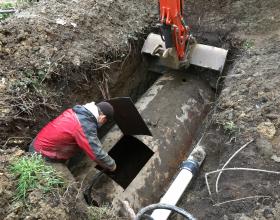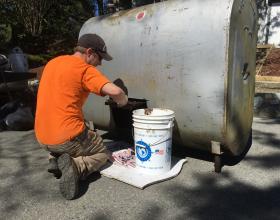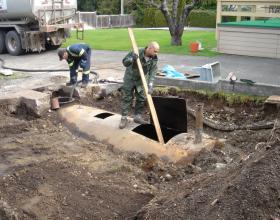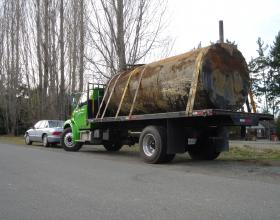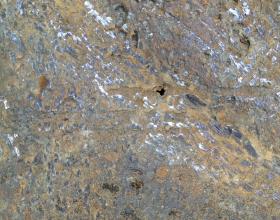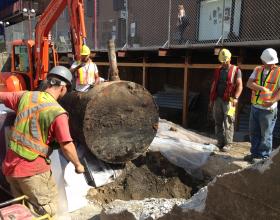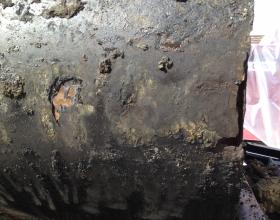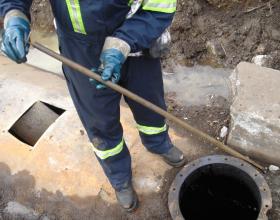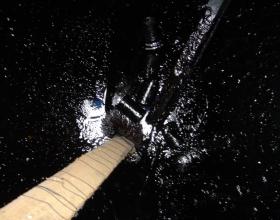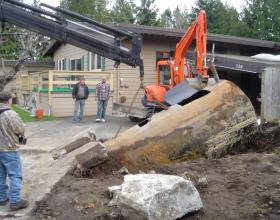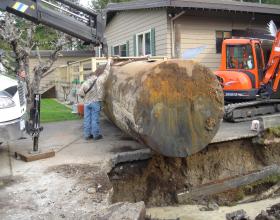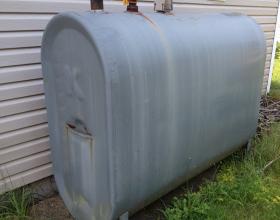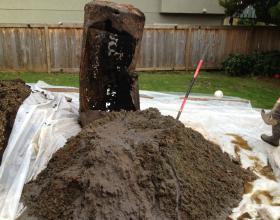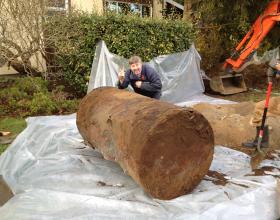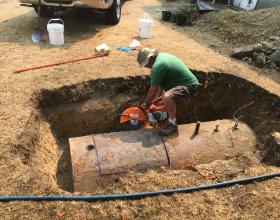Pacific Group Developments is a locally owned and operated oil tank removal company; servicing the Victoria, Duncan and Nanaimo, BC areas.
At Pacific Group Developments our technicians specialize in residential and commercial buried and above ground oil tank removal and replacement. We also remove furnaces and ducting.
We practice environmentally responsible procedures, ensuring a safe and contained work area. Pacific Group Developments also specializes in soil testing and soil remediation to assist our clients in the most cost effective ways.
We are covered by Worksafe BC and are insured to give you peace of mind. If you have, or suspect you have, an oil tank on your property that needs removal or replacement, we can help.
Why You May Need an Oil Tank Removed or Replaced
Home heating oil is a hazardous substance. The average home may be storing up to 250 gallons (1,100 litres) of oil above ground in a metal tank or buried in the yard. All of these tanks will leak eventually, some in as little as 5-10 years, and will require removal.
Leaking oil contaminates everything it comes into contact with, including the soil, the ground water, basements, crawl spaces and the natural environment – including your neighbours yards or adjoining municipal or provincial lands. Your home insurance policy EXCLUDES losses caused by oil contamination and damage done, by whatever cause, to the ground on your premises.
You will be held legally responsible for clean up costs, which can be over $100,000.
According to the North American Petroleum Institute, “Underground oil tanks are like ticking time bombs.”
Because they are out of sight, buried oil tanks can cause damage without your knowledge. This damage could occur over years. Water can also leak into your oil tank, reducing your useable capacity and fouling your burners.
Heating oil is very pervasive and will soak into all porous substances, including concrete. It has a very strong odour which can be offensive to many people. However, most leaks for buried oil tanks go undetected until the removal of the oil tank from the ground.
It is very common for oil to find its way into the perimeter drainage system of the house where it will flow into the public storm drains. When this happens, a strong oil odour can permeate the inside of the house. In worse situations, the oil will find its way into a neighbor’s drainage system, causing the same smelly problem. Oil entering storm systems by any service connection pollutes public property and will result in large clean up costs not covered by insurance.
Oil Tank Removal and Selling Your Home
Buried oil tanks can become a problem when selling, mortgaging or insuring your home, especially for older homes that have been converted to natural gas. Many times the old oil tank was left buried in the ground and is now awaiting removal. Realtors are aware of the potential for buried oil tanks on properties.
Many homeowners are unaware they may have a buried oil tank requiring removal, but homes on Vancouver Island were often heated by furnace oil buried underground, particularly prior to natural gas becoming available in 1957. The oil tank was often buried as a luxury to avoid large, unsightly above ground oil tanks. Most buried oil tanks were located in the back or side yards of residences with the oil tanks ranging in size from 200 gallons to 1000 gallons.
As conversions to natural gas took place these oil tanks were commonly left buried underground, sometimes having been pumped out of any remaining oil but not always.
Buried oil tanks may not become an issue until a home owner decides to sell. At that time the buyer will have an inspection done on the home. The inspections are usually a subject clause in the purchase contract and are done prior to removing a condition of sale. As with realtors, many mortgage lending institutions will inquire about buried oil tanks and may require verification of their removal prior to registering a mortgage over the home. Insurance companies are also aware of the liability issues of buried oil tanks and typically require their removal with accompanying documentation.
Pumping out Oil Tanks
Oil tanks need to be pumped before being removed to ensure no oil is spilled during the removal process. Oil also needs to be pumped prior to decomissioning oil tanks.
Oil transferring is sometimes needed from an old tank to a new tank.
Oil Furnace Removal
Pacific Group Developments removes all heating equipment including above ground and buried oil tanks, oil fired furnaces, oil fired boilers and forced air boil fired furnace ducting. There are several reasons to remove your old oil furnace and ducting but usually it is a cost driven decision where clients choose to go with a more cost effective heating source. The benefits of removing your old oil furnace and ducting are gaining a lot of extra floor space and head space in your basement. Sometimes oil furnaces are in difficult locations and need to be cut into pieces to allow for removal. The oil fuel lines need to be properly decommissioned and capped off to prevent any residual oil from leaking out. Call us for a free quote.
The Legal Consequences Of An Oil Spill
Heating oil is a dangerous substance. If it escapes from your premises, you are considered negligent. You will be held strictly liable at law for any damages done to the property of others. You will also be liable for clean up costs, which can be more than $100,000.for a buried oil tank.
You are considered responsible for the leaking oil even if:
- You were not home at the time the oil escaped
- The home is rented to others and you do not live on the premises,
- The oil leaks at an imperceptible rate over a long period of time,
- The oil tank is buried underground and you are unaware that it is leaking,
- The leak occurs as a result of damage done during an earthquake
Leaking Oil Tank Removal and Cleaning Up
Every oil spill or leakage MUST be reported to the Ministry of the Environment (M.O.E.). The M.O.E. is empowered to take immediate action to start clean up operations. You might not have a say in how the clean up is done, and you will be expected to pay all clean up costs. Typical clean up operations can include:
- Excavation and removal of soil from contaminated properties.
- Ditching and trenching to create containment areas.
- Soil remediation.
- Replacement of contaminated soil with clean soil.
- Temporarily vacating the premises.
Heating oil has a half-life of 200 days. It will break down naturally over time and under some conditions the natural processes are all that is required to satisfactorily clean up the spilled oil. Pacific Group Developments can accelerate the natural process by aerating and fertilizing the soil, or introducing specially developed oil consuming bacteria to the contaminated site.
How Oil Tanks Leak
Oil tanks buried underground will rust through in as little as 5-10 years. Buried tanks can begin to leak and slowly contaminate your property without your knowledge. The oil can also suddenly break through and quickly drain into the ground. Either way, leaking oil is a disaster and removal of the tank is necessary.
In addition to rusting through from the outside, oil tanks are also being corroded from the inside out. The corrosion is caused by small quantities of water and other chemicals which have settled to the bottom of the oil tank. This process affects buried oil tanks, above ground oil tanks and oil tanks in basements in the same way.
It is almost impossible to determine how much corrosion damage an oil tank has sustained or how much longer it will last until removal and cutting it open.
Our Oil Tank Removal Services
As a property owner, the prospect of a leaking oil tank may be alarming, but Pacific Group Developments is here to help. We specialize in safe and efficient buried and above ground oil tank removal and replacement in the Greater Victoria, Duncan and Nanaimo areas. Pacific Group Developments can also help you convert from a buried oil tank to an above ground oil tank
A preliminary assessment can often be accomplished using sight and smell. Obvious signs of oil tank failure or contamination would be oil pooling in the excavation area or oil floating on water, which may have accumulated in the tank basin. Soil from the bottom, sides and ends of the buried oil tank basin should be viewed and smelled to determine the presence of oil. Soil and ground water that has been contaminated must be remediated. In most cases today, oil has not contaminated soils or ground water; however; as time passes we will see much more soil contamination.
After Pacific Group Developments’ technicians locate a buried oil tank on the property we will walk you through the process required for safe removal of the buried oil tank in compliance with government regulations. At this time we will offer an estimate for the buried oil tank removal and an above ground oil tank instalment, if required.
Process:
- Prior to excavation Pacific Group Developments contacts BC One Call (Dial Before You Dig) to learn the location of underground utilities such as telephone, hydro, and gas.
- File permits.
- Make sure any remaining oil has been removed.
- Excavate the site.
- Remove the buried oil tank and have the inspector attend the site to certify.
- Dispose of the old oil tank at an approved facility.
After the removal of your buried oil tank, Pacific Group Developments will provide you with documents verifying the oil tank removal was completed. You will receive a copy of the permit and final inspection certificate by a government appointed inspector. Pacific Group Developments issues this paperwork for your peace of mind and use when dealing with mortgage companies, banks, realtors, insurance companies and prospective purchasers.
If the oil tank has leaked contaminants into the ground, resulting in soil contamination, a soil clean up and disposal to a special remediation site will be required. Pacific Group Developments provides environmental remediation including:
- Soil testing.
- Soil removal and disposal.
- Replacement of the contaminated soil with clean soil.
- Verification the work was completed.
- Reporting of soil Samples.
- Reporting of the tank removal process.
- Risk assessment.
Pacific Group Developments removes buried oil tanks and above ground oil tanks, both inside and outside. We also remove buried oil tanks from beneath buildings and provide structural support if needed to remove oil tanks or contaminated soils.
Oil Tank Removal Cost
The average cost for removing a 300 gallon oil tank is between $1500.00 - $4000.00 depending on location on the property, whether the tank is buried or above ground, if there is a concrete pad poured above or below the tank, accessibility, contents of tank, ect.
Pacific Group Developments is a licensed company and we comply with permitting requirements.This means you will get a certificate of compliance and permits will taken out for your works to protect you and future buyers of your property. This will satisfy your insurer and give you peace of mind.

